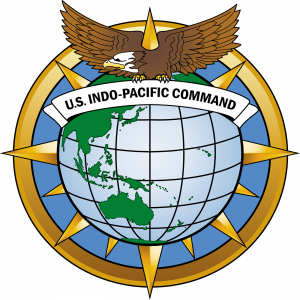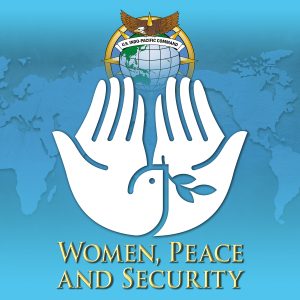October 28, 2020 (US) | October 29, 2020 (Asia)
View the Event Recording on YouTube
Featuring
Commander Philippa Hay
Royal Australian Navy
Rear Admiral Arti Sarin
Indian Navy
Captain Junko Kawashima
Japan Maritime Self Defense Force
Major General Suzanne P. Vares-Lum
U.S. Army, U.S. Indo-Pacific Command
Moderated by Bob Girrier (RADM, USN, ret.), President, Pacific Forum
Key Findings
In commemoration of the 20th anniversary of UN Security Council Resolution 1325 (UNSCR 1325) on Women, Peace and Security, which was unanimously adopted on Oct. 31, 2000, U.S. Indo-Pacific Command and Pacific Forum co-hosted a 90-minute webinar featuring senior women defense leaders from the United States, Japan, Australia, and India. This webinar served as an opportunity to highlight how the defense sector plays a role in advancing the Women, Peace and Security (WPS) agenda, which recognizes the gendered impacts of armed conflicts and calls for strengthening women’s inclusion across the full spectrum of peace and security. The webinar also drew attention to how the values underpinning WPS contribute to resilient, stable, and prosperous societies across the Indo-Pacific.
In addition to celebrating the anniversary of UNSCR 1325 on WPS and reviewing how its agenda has evolved through defense and security sector implementation, this timely webinar underscored how our shared values foster secure and inclusive societies. It also emphasized how a Free and Open Indo-Pacific enables new opportunities for previously untapped resources, innovation, and leadership while highlighting all four countries’ expressed commitment to promoting Women, Peace and Security within the Indo-Pacific.
Key findings from this event are described below.
I. The Importance of the Women, Peace and Security (WPS) Agenda
Much of the webinar centered on the importance of the WPS agenda. The need for increasing the number of women uniformed personnel was a central theme of the discussion. Panelists also explored the ways in which WPS intersects with armed conflict, maritime security, and disaster response planning, revealing a clear link between the WPS agenda and regional and global stability.
Promoting women’s participation in the military: Panelists discussed how integrating women into the military can improve the effectiveness of armed forces and enrich civil-military relations. Encouraging women to enter the armed forces doubles the pool of talent and diversifies the skills of recruits. Moreover, deploying mixed-gender teams during military engagements can strengthen communication with host populations – in some contexts, cultural and social barriers prevent local women from interacting with male troops, which hinders vital information-sharing and intelligence-gathering. Further, the presence of women peacekeepers is associated with a reduction in sexual exploitation and abuse, improved reporting on gender-based violence (GBV), and better support for survivors. Women troops also serve as a visible sign of a government’s commitment to gender equality, and their presence in the military signals to women and girls that it is possible to transcend traditional gender roles.
Armed Conflict: The WPS agenda is essential to mitigating and preventing armed conflict. Two of the four WPS pillars – protection and prevention – are crucial to safeguarding women and girls from disproportionately high rates of GBV committed by contesting armed forces and family or community members amid armed conflict. During periods of intense violence, incidents of sexual assault, intimate partner violence, and other forms of GBV often escalate due to a combination of factors, including a breakdown in law and order, the normalization of violence, and widespread trauma.
There is also a connection between gender equality and conflict prevention. Evidence suggests that nations with higher rates of gender parity – particularly in the political, economic, and educational spheres – are significantly less likely to experience internal and external conflict than those with more acute levels of inequality.
Maritime Security: It is critical that we expand our understanding of the relationship between WPS and maritime security. One panelist drew on her experience working for NATO during the European migrant crisis to emphasize the need for implementing WPS in the maritime context. The migrant crisis, which saw thousands of people arriving in European countries from across the Mediterranean Sea, was accompanied by high rates of transnational crime that disproportionately affected women and girls, such as sex trafficking.
Natural Disasters: More than 70% of natural disasters globally occur in the Asia-Pacific region. Japan, for example, is highly susceptible to earthquakes and tsunamis. In the aftermath of these disasters, women and girls are exceedingly vulnerable to gender-based violence due to weakened law enforcement and widespread disorder. Adopting a gendered perspective in disaster response planning is vital to preventing disaster-related GBV and providing support for survivors. Additionally, a gender perspective in disaster planning and response better enables women to access relief and recovery resources. Climate change is causing extreme weather patterns to grow in intensity and magnitude, making it all the more urgent to apply a gendered lens in responding to environmental catastrophes.
II. National Progress Towards Implementing WPS in the Security Sector
All four panelists reflected on the positive changes to women’s military participation that have occurred over the course of their careers. Several common areas of progress emerged, including gains in women’s military representation, an expansion in the roles available to women personnel, a pivot towards evaluation based on ability rather than gender, and an increase in actions taken by governments to support women’s integration into the military.
Australia: Women were not able to join Australia’s military as full-serving officers until the 1990s. However, women now work in a wide variety of roles, including as active combat personnel and in “softer” capacities (e.g., in health and logistics). As of 2020, women account for around 20% of the Australian military. They comprise 17% of the Australian navy, up ten percentage points from 1992. There has also been a shift in attitudes towards women among military personnel, with younger recruits now viewing their peers on the basis of merit as opposed to gender. The Australian government has introduced measures to strengthen women’s military participation; in 2012, Australia adopted its first National Action Plan (NAP) on the implementation of UNSCR 1325, making it the first country in the Asia-Pacific to formulate a WPS NAP.
India: Although women have been able to join the medical branch of India’s armed forces since 1943, they have only been able to enroll as short-service commission officers in judicial, logistical, and educational branches since 1992. As of 2020, women remain ineligible for most active combat roles. However, there have been some significant breakthroughs for women’s military inclusion in recent years. More than 100 women were recruited to the lower ranks of India’s military police for the first time in 2020, and women currently comprise approximately 15% of India’s UN peacekeeping missions. Meanwhile, India’s military has increasingly adopted gender mainstreaming in decision-making and execution. Moreover, the government has harnessed the media and education to promote the armed forces as a “recognized and respectable” career for women.
Japan: Few women held senior roles in Japan’s military during the late 1990s. As of 2020, women account for 7.4% of Japan’s armed forces, marking an increase from the previous year. Moreover, “almost all restrictions” that prevented women from serving in certain roles have now been abolished, and Japan’s military currently boasts several high-ranking women. Between 2018-2020, Japan recruited its first woman fighter pilot and its first woman submariner. The growth in the number of senior servicewomen was cited as a factor in enhancing women’s inclusion, as high-ranking women can offer guidance to fresh female recruits. In addition, the government has taken steps to improve women’s participation and integrate a gendered perspective into military operations. For example, Japan’s Ministry of Defense announced an initiative for promoting women’s empowerment in 2019, and measures have been introduced to prevent sexual harassment within the armed forces. Moreover, the military now offers paid parental leave for both women and men, which helps to prevent women personnel from being burdened with uneven childcare demands.
United States: As of 2020, women constitute approximately 15% of the US military and 10% of the most senior roles. Over the past two decades, there have been “many firsts”; in 2008, General Dunwoody became the first woman four-star general to lead all army logistics, and in 2014 Admiral Howard became the first woman naval officer. In addition to these achievements, the US government has introduced several initiatives to encourage gender mainstreaming in military activities. They have allocated funding to create a gender advisor role for the US Indo-Pacific Command (USINDOPACOM), and have worked in partnership with Australia and New Zealand to organize a gender advisor course. The US is currently implementing its 2019 WPS Strategy after releasing its first WPS NAP almost a decade ago in 2011 and adopting a WPS Act in 2017. The 2017 Act made the US the first country globally to possess a comprehensive law on UNSCR 1325. In 2020, the US Department of Defense released its associated WPS Strategic Framework and Implementation Plan.
III. Remaining Challenges in the Implementation of the WPS Agenda
All four panelists touched on remaining challenges to women’s military participation. Despite changes in how younger personnel view gender, stereotypical attitudes towards women continue to be prevalent among senior officials. Moreover, many of the women focused on the difficulties of balancing family obligations with a military career, which is unsurprising given that women in the Asia-Pacific perform four times more unpaid work than men.
Several outstanding issues were identified regarding the implementation of all aspects of the WPS agenda. These issues included ongoing armed conflicts and the negative impacts these have on women and girls, an uptick in climate change-induced disasters, and the Covid-19 pandemic, which is disproportionately affecting women around the globe. The pandemic has led to steep rates of unemployment among women and exacerbated domestic violence.
IV. Personal Experience as a Woman in the Military
At the end of the webinar, each panelist provided a closing message about their experience as a woman in the military. Panelists discussed the early difficulties they faced in entering a male-dominated environment and the pressure they felt to conform to a masculine culture. However, speakers stressed that “being the best you can be” is the most important attitude to take. Panelists also discussed the value of having male mentors and supporters, and urged any woman who wants to join the military to do so.
This document was prepared by Jennifer Howe. For more information, please contact Dr. Crystal Pryor ([email protected]), Director of Nonproliferation, Technology, and Fellowships at Pacific Forum. These preliminary findings provide a general summary of the discussion. This is not a consensus document.
This event was held with support from U.S. Indo-Pacific Command









